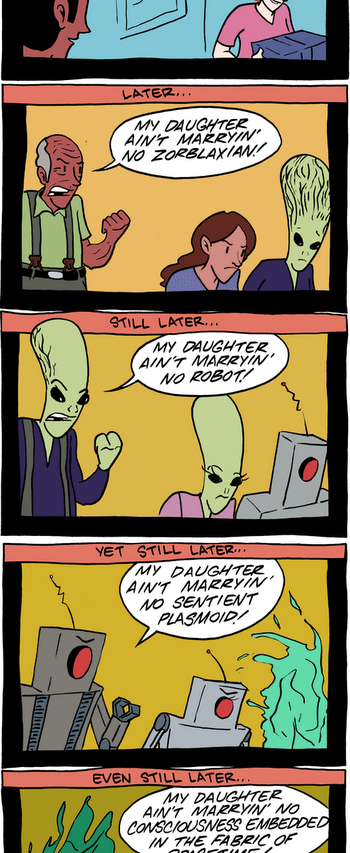Our last post, simply a picture of a joyous Audrey Hepburn leaping in the air with the title “Does Anybody Seriously Think We Can Do Better than This?,” provoked a long comment thread. Michael Anissimov posted a
comment (and then
reposted it on his own blog with a short response to it):
Our evaluations of “goodness” are not objective truths, just subjective facts about the structure of our own minds. The opportunity to modify and enhance those minds will vastly increase the space of things we can understand and appreciate. This will allow us to create new forms of attractiveness and wonder that we lack the facilities to appreciate now.
Commenter Brendan Foht
notes that Mr. Anissimov’s line of argument “is at the crux of the most radical aspects of transhumanism,” and neatly explains its contradiction:
When ‘goodness’ is made completely contingent on the structure of our historically/biologically conditioned minds, we make room for the possibility of new kinds of goodness, if we alter the historical or biological conditions that structure our minds…. [But] if our concepts of goodness are structured by our current situation, what reasons could we… have for choosing new kinds of goodness?
The paradox Foht points out is a fundamental one for transhumanists. They face the necessary task of destroying existing value systems, but they always seem to attempt this task by neutralizing values
as such, declaring them arbitrary, contingent, publicly unsettleable, a matter of personal choice, etc. The problem is that the value systems they are attempting to set forth as higher alternatives are then necessarily also undercut. As I’ve noted before (
here and
here), if transhumanists succeed in removing the reasons we
shouldn’t embrace some modification, they then leave us without any reasons why we
should. In short, the inherent problem with arguing for relativism is that you can’t convince anyone it’s better.
Oh, yeah, he went there
Transhumanists are not truly relativists, however; they just have a warped value system, the deep incoherence of which often leads them to fall back on relativistic arguments in place of direct arguments for why their goods ought to replace normal human ones. If they were truly relativists, their writing would not betray the high-minded moral posturing that it does. Take this part of the same comment from Mr. Anissimov (as continued in his re-posting of it):
[E]ven though I’m favor of morphological freedom (rather than the morphological fascism that I have to look and think a certain specific way, the way it’s been for over 200K years) [that] doesn’t mean that I discourage people from rejecting transhumanism entirely and living only among other humans…. Today, for instance, there are some people that only choose to live among their own race, for fear that race-mixing leads to irrevocable societal chaos. It is only natural to fear that species-mixing in a society could lead to problems, but I’ll bet that some combinations of species could lead to a harmonious equilibrium.
Yes, I went there…. Conservatives seem to often believe in the hypothesis that [the] more we’re alike, the better we can get along. Liberals argue that we can get along despite our diversity.
I guess that makes us “morphological fascists.” Which one of the Futurisms bloggers do you suppose is morphological Mussolini? Or is it that we’re the morphological equivalent of racists, and Mr. Anissimov is the morphological Martin Luther King?
It’s hard to know where to begin with this sort of uninformed and unserious argument, teeming with straw men. You might start by wondering who are the people that Mr. Anissimov claims fear living among other species — even though we have
always lived among other species. (The problem, of course, is that transhumanists want to create new species of such higher intelligence than ours that they might relate to us in ways akin to how we relate to dogs, cows, or mosquitoes.) You might also wonder what his comment has to do with Charles Rubin’s original question of whether “we can do better” than that image of Audrey Hepburn, a picture that
Rubin says shows us “not
the peak of human history or existence, but…does show us
a peak of human experience.”
What Mr. Anissimov seems to be getting at is that to affirm the unsurpassable beauty of the Hepburn photo is to commit a sort of discrimination, or species-racism. He wants to turn Rubin’s question on its head: To say that we couldn’t do better is to say that a member of any other species would be less beautiful, which is the same as saying that a member of any other race would be less beautiful.
But the actual history of the fight against racism reveals a picture very different from the one he implies, in which people somehow came to appreciate that race is contingent and so we should not begrudge each race for appreciating its own as best. On the contrary, Martin Luther King and others fought for equality by illustrating our commonality rather than our differences — by demonstrating that all races are equally human, possessing of equal human dignity, and so ought to be treated with equal respect. We can “get along despite our diversity” because we are human, in a way that, say, we should not expect humans and insects to get along despite their diversity.
Finally, I can’t resist noting Mr. Anissimov’s goofily self-congratulatory depiction of transhumanism as the sort of thing that kids will experiment with, perhaps when they go off to college: “I do, however, think that children should be able to do what they want with themselves after a certain age, and I doubt that Christian conservative parents will be able to stop their curious and neophilic children from embracing transhumanist technologies.” This brings to mind the following comic, which he would seem to have to think should be taken seriously (click to enlarge):


